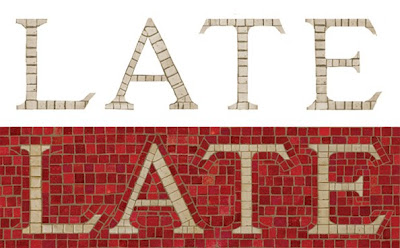As mentioned in the first “
limestone” post
"The "limestone" island", limestone is associated with mosaic art. It is actually crucial. In this post I am
drawing from my own personal experience to show that by employing it in your mosaic making routine you can learn to make better mosaics.
In the picture above, you can see a mosaic artist making a mosaic on a lime putty mortar which acts as a temporary base. This method is known as
the double reverse method. This is the method that I have learned in Ravenna and the one I prefer.
Lime putty is achieved with the combination of lime chalk or limestone fragments and water and its known roles are as a binding agent, a covering coat on a structure, or as one component in the creation of walkways or mosaics.
The double reverse method is extremely time-consuming and requires that the mosaic artists gets involved with products that only architects/constructors/builders get to work with. However, it should not fail you.
The DR (double reverse) method means that you get to work on your mosaic directly, that is, "what you see/make is exactly what you get". Your mosaic is not supposed to be turned around, like we do with the indirect method where pieces are adhered onto paper/fabric the wrong side up and then turned around and transferred onto the final base (wall, table, floor etc)
The DR method involves making your mosaic on a lime putty mortar which will then be removed once it has dried. The mosaic is turned around, the mosaic gets cleaned from the lime putty and after going through the final stages, the mosaic is secured in in its final place.
When each tessera (the "official" term for "mosaic tile" deriving from Greek τέσσερα meaning four/four angles/square) is placed into the lime putty you get the feeling of something "living and breathing", that feeling that was probably experienced by mosaicists in the past when they embellished church vaults with golden tesserae which they arranged mathematically and gracefully in such angles into the mortar in order to achieve reflections of light, i.e. glory.
And it's not just for the "experience" of that old feeling. The past is long gone and mosaics made that exact way are rare today. What's more important, at least to me, is that this method provides a combination of the following two benefits.
1. It gives you the opportunity to learn and/or practice mosaic making the flexible way
The DR method is about TIME and FLEXIBILITY both imperative for a beginner who is bound to make mistakes and who needs to "see" the work and how the tessera interact with each other according to how they are placed on the lime putty mixture. The lime putty mortar is temporary and flexible and tesserae can be removed hours and days after. Even in the absence of a teacher, the learner, takes up the role of the "judge" and as he or she can re-examine the work.
How many times have we found ourselves saying "this is as far as I can go" and "this is the best I can do" and then the next day we contradict our own judgement and want to change everything. The DR method is as flexible as it can get and it will help you work "miracles".
2. It provides you with a unique method to learn from ancient mosaics.
With the DR method, the design of the mosaic you are about to make is copied onto the lime putty mortar. This means that ancient mosaics can be reproduced piece by piece as long as you know how to follow some simple guidelines which all schools (at least, as far as I know, in Ravenna) will teach you.
To my humble view, a student of mosaic should first learn how to copy mosaics. Especially ancient ones because all the fundamentals of mosaic art are to be found there. Andamento. Shapes. Contours. Colour balance. You can deviate from tradition once you have learned it. I would never recommend someone starting from crushed pottery or vitreous glass mosaics working on a mosaic pattern/design that has not been already made.
If you notice the work of modern Ravenna artists, you will see that they have gained from learning from ancient mosaics. Roman and Byzantine.
If the past cannot teach the present and the father cannot teach the son, then history need not have bothered to go on, and the world has wasted a great deal of time. ~Russell Hoban
I will continue exploring the "limestone" theme in the next post. The image links back to its source. If you want to use this text please kindly indicate the source.
(not me in the pic - image credit: hotelsravenna.it)

























